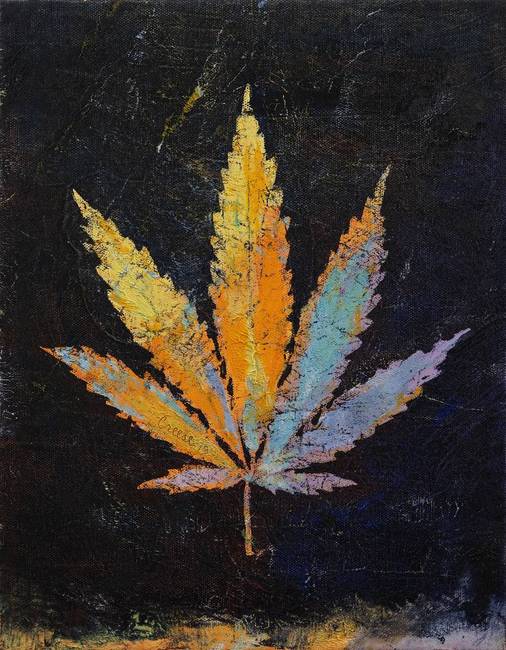 (Illustration above: ‘Cannabis,’ by Michael Creese, found here).
(Illustration above: ‘Cannabis,’ by Michael Creese, found here).
Sunshine slowly being replaced by rolling, big-fluffy clouds this Monday afternoon on California’s north coast — supposedly, returning to wet-times tomorrow, with first some light showers, then increasing to the heavy-rain category by Wednesday, consuming rest of the week.
Farewell to a weekend of absolutely-gorgeous weather, motif of ‘as good as it gets..’
And surfing over the weird-ass, and absolutely-not-gorgeous news out of DC with the T-Rump/Vlad drama, I spied a few stories on the news cycle today on how seniors are really taking to marijuana — as if: we’re supposedly the original stoners, though, a few became Republicans — and how the booming cannabis market is neglecting the olds.
Via the Guardian this morning:
As attitudes towards cannabis shift, the fastest-growing group of users is over 50 — and marijuana’s popularity among seniors is beginning to change the American experience of old age.
Why are more seniors getting high?
It might make more sense to ask: “Why not?”
As adults reach retirement, they age out of drug tests and have far more time on their hands.
Some feel liberated to abandon long-held proprieties.
…
The seniors using cannabis today aren’t your parents’ grandparents.
The generation that camped out at Woodstock is now in its seventies.
They’ve been around grass long enough to realize it’s not going to kill them, and are more open to the possibility it will come with health benefits.
(By contrast, in a survey of one, my 100-year-old grandmother recently said she had no interest in medical marijuana.)
Seniors’ affinity for weed is beginning to ripple across the US healthcare system.
A 2016 study found that in states with access to medical marijuana, those using Medicare part D — a benefit primarily for seniors — received fewer prescriptions for other drugs to treat depression, anxiety, pain, and other chronic issues.
…
For the industry, seniors’ newfound interest in cannabis is a business opportunity.
The Colorado edibles company Wana Brands, among many others, sells cannabis products reminiscent of medicines familiar to seniors.
Wana sells extended release capsules as well as products with different ratios of THC and CBD, which intoxicate users to different degrees and can have a variety of effects on ailments
In that respect, Mary Clifton, reportedly an MD, has a good piece from last week at the Stamford Advocate on how the marijuana industry can capture the oldersters — a few noted snips:
As a internal doctor for over two decades with a speciality in cannabis, I have noticed more seniors asking questions about medical cannabis in the past few years as states continue to legalize it.
The elder demographic is becoming more educated about the benefits of cannabis and realizing some of the risks of it may have been overstated.
They are turning to cannabis as an alternative solution to treat age-specific ailments, like arthritis.
And tips on approach — first there’s money:
While seniors make up much of the prescription market, but as the pharmaceutical industry is putting stress on the older demographic.
Indeed, a recent report shows that while generic drug prices have declined, brand drug prices have almost doubled since 2008, and those on Medicare are the ones who feel the brunt of it.
Findings show that in 2015, those on Medicare spent $2,000 a year or more out of pocket on brand-name drugs, which is nearly double what was spent just five years prior.
Because of the unpredictableness of the pharmaceutical industry, seniors have and will continue to look for alternative solutions for ailments.
Findings from the National Survey on Drug Use and Health showed that usage of cannabis products among seniors grew by 250 percent between 2006 and 2013.
And a report from Deloitte shows an increase likelihood that older generations will use cannabis in the future.
Bad health:
Marijuana and CBD have been shown — either through studies or anecdotally — to help with a number of health-related issues, many or which seniors have, including those which are specifically age related.
The older population must deal with arthritis, insomnia, osteoporosis and everyday aches and pains, among other issues.
This a huge opportunity for cannabis companies.
Consider having a marketing strategy aimed specifically at addressing these health issues in the older demographic, ensuring you products and services are addressing specific pain points and offering solutions tailored to seniors.
Seniors have more disposable income:
Millennials are in college, beginning their career and/or starting a family, so while they may be the hot market they are also broke.
Baby Boomers and Gen Xers, on the other hand, have fewer responsibilities and obligations.
Their kids are grown up, their homes are paid off and their careers are either at a comfortable level, or retirement is a way of life.
By controlling 70 percent of the country’s disposable income, older people can spend more on discretionary goods, including cannabis products (avocado toast hasn’t caught on yet).
However, Big Pharma ain’t helping — via ArsTechnica last Friday:
Of the nearly $30 billion that health companies now spend on medical marketing each year, around 68 percent (or about $20 billion) goes to persuading doctors and other medical professionals — not consumers — of the benefits of prescription drugs.
That’s according to an in-depth analysis published in JAMA this week.
The study broke down exactly how health companies convinced us to spend enormous sums on our care between 1997 and 2016.
In that time, health companies went from spending $17.7 billion to $29.9 billion on medical marketing.
Meanwhile, US healthcare spending hit $3.3 trillion, or 17.8 percent of the GDP, in 2016.
As both a Baby Boomer and a retiree, I don’t know about all that ‘disposable income’ bullshit — pot is just good medicine…